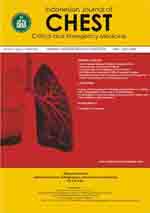
Relationship between Pulse Transit Time, Oxygen Desaturation Index clan Blood Pressure with Apnoea-Hypopnea Index in Obese Patients
Rattu R1, Kamelia T2
1Divisi Respirologi dan Penyakit Kritis RSUPN Ciptomangunkusumo/FKUI
Abstract
Background Obesity is a complex chronic disease that can impact sleep quality. In assessing sleep physiology, polysomnography is one of the methods used to record physiological parameters related to sleep, such as Apnea-Hypopnea Index (AHI), Pulse Transit Time (PTT), and Oxygen Desaturation Index (ODI). These parameters can be used to establish a diagnosis of sleep disordered breathing. Objective to know the relationship between AHI with Pulse Transit Time (PTT), Blood Presure and Oxygen Desaturation Index (ODI) in patient with obesity. Methods This study is a cross-sectional analytical study conducted at RSUPN Cipto Mangunkusumo assessing the relationship between polysomnography examination parameters, namely AHI, ODI and PTT, in obese patients (BMI ≥25 kg/m2). Results Obese patients with increasingly severe AHI were found to have significantly higher ODI (p<0.001), with a median ODI in the mild AHI group of 11.00, moderate 32.50, and severe 68.00. PTT between AHI groups were not significantly different (p=0.907). No significant relationship was found between ODI and PTT (r=-0.010, p=0.952). A positive correlation was found between systolic blood pressure and AHI score (r = 0.221, p = 0.030).
Discussion The positive correlation between AHI and ODI in this study is in accordance with the results of previous studies. ODI has the potential to be a screening parameter for sleep disordered breathing and a predictor of AHI in obese populations. PTT in previous studies was found to be ineffective in assessing sleep quality because it was influenced by age and other factors. Increased systolic blood pressure in previous studies has also been associated with increased AHI scores.
Conclusion ODI in obese patients correlates well with AHI. PTT was not found to be associated to either ODI or AHI. High systolic blood pressure is correlated with higher AHI.
Keywords: polysomnography, apnea-hypopnea index, pulse transit time, oxygen desaturation index, sleep disordered breathing, obesity



